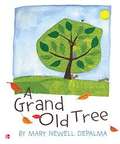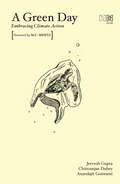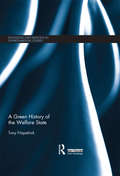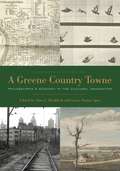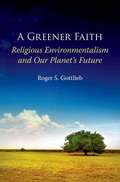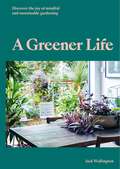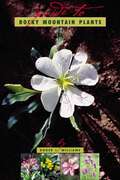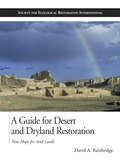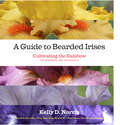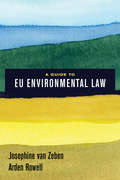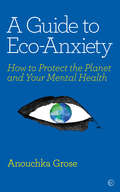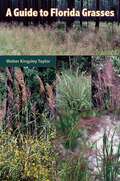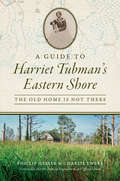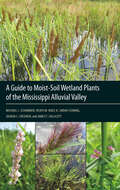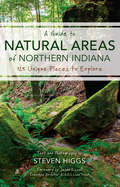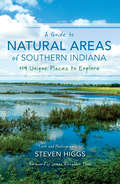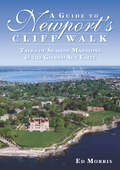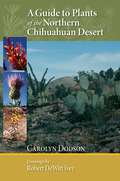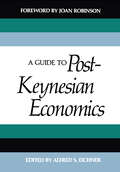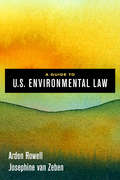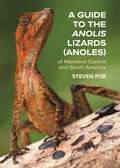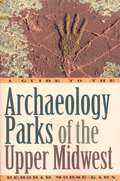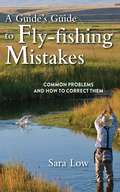- Table View
- List View
A Green Day: Embracing Climate Action
by Jeevesh Gupta Chittranjan Dubey Anandajit GoswamiAn Engaging Compilation of Perspectives on Climate Activism The impassioned essays, noteworthy profiles and first-person narratives in this anthology champion grassroots and global environmental movements that have persuaded policymakers and mobilized communities to take note of the worsening state of the natural order. From the Global South to the Global North, change advocates and those experiencing the thick of the emergency revisit the tipping points in their activism journey, lay out harsh truths about the extent of damage caused and offer scalable solutions to combat the mounting crisis. Outlining their rage, despair, fears and hope for the future, the campaigners underscore that there may be reasons to be optimistic despite the dreary reality we find ourselves in. While calling for collective action, these wide-ranging, inspiring and urgent stories reflect a diverse landscape of climate activism and are enough evidence that a sea change is possible.
A Green History of the Welfare State (Routledge Explorations in Environmental Studies)
by Tony FitzpatrickEnvironmental problems – particularly climate change – have become increasingly important to governments and social researchers in recent decades. Debates about their implications for social policies and welfare reforms are now moving towards centre stage. What has been missing from such debates is an account of the history of the welfare state in relation to environmental issues and green ideas. A Green History of the Welfare State fills this gap. How have the environmental and social policy agendas developed? To what extent have welfare systems been informed by the principles of environmental ethics and politics? How effective has the welfare state been at addressing environmental problems? How might the history of social policies be reimagined? With its lively, chronological narrative, this book provides answers to these questions. Through overviews of key periods, politicians and reforms the book weaves together a range of subjects into a new kind of historical tapestry, including: social policy, economics, party politics, government action and legislation, and environmental issues. This book will be a valuable resource for students and scholars of environmental policy and history, social and public policy, social history, sociology and politics.
A Greene Country Towne: Philadelphia’s Ecology in the Cultural Imagination
by Alan C. Braddock Laura Turner IgoeAn unconventional history of Philadelphia that operates at the threshold of cultural and environmental studies, A Greene Country Towne expands the meaning of community beyond people to encompass nonhuman beings, things, and forces.By examining a diverse range of cultural acts and material objects created in Philadelphia—from Native American artifacts, early stoves, and literary works to public parks, photographs, and paintings—through the lens of new materialism, the essays in A Greene Country Towne ask us to consider an urban environmental history in which humans are not the only protagonists. This collection reimagines the city as a system of constantly evolving constituents and agencies that have interacted over time, a system powerfully captured by Philadelphia artists, writers, architects, and planners since the seventeenth century. In addition to the editors, contributors to this volume are Maria Farland, Nate Gabriel, Andrea L. M. Hansen, Scott Hicks, Michael Dean Mackintosh, Amy E. Menzer, Stephen Nepa, John Ott, Sue Ann Prince, and Mary I. Unger.
A Greene Country Towne: Philadelphia’s Ecology in the Cultural Imagination
by Alan C. Braddock Laura Turner IgoeAn unconventional history of Philadelphia that operates at the threshold of cultural and environmental studies, A Greene Country Towne expands the meaning of community beyond people to encompass nonhuman beings, things, and forces.By examining a diverse range of cultural acts and material objects created in Philadelphia—from Native American artifacts, early stoves, and literary works to public parks, photographs, and paintings—through the lens of new materialism, the essays in A Greene Country Towne ask us to consider an urban environmental history in which humans are not the only protagonists. This collection reimagines the city as a system of constantly evolving constituents and agencies that have interacted over time, a system powerfully captured by Philadelphia artists, writers, architects, and planners since the seventeenth century. In addition to the editors, contributors to this volume are Maria Farland, Nate Gabriel, Andrea L. M. Hansen, Scott Hicks, Michael Dean Mackintosh, Amy E. Menzer, Stephen Nepa, John Ott, Sue Ann Prince, and Mary I. Unger.
A Greener Faith: Religious Environmentalism and Our Planet's Future
by Roger S. GottliebIn a time of darkening environmental prospects, frightening religious fundamentalism, and moribund liberalism, the remarkable and historically unprecedented rise of religious environmentalism is a profound source of hope. In A Greener Faith , Roger S. Gottlieb chronicles the promises of this critically important movement, illuminating its principal ideas, leading personalities, and ways of connecting care for the earth with justice for human beings. He also shows how religious environmentalism breaks the customary boundaries of "religious issues" in political life. Asserting that environmental degradation is sacrilegious, sinful, and an offense against God catapults religions directly into questions of social policy, economic and moral priorities, and the overall direction of secular society. Gottlieb contends that a spiritual perspective applied to the Earth provides the environmental movement with a uniquely appropriate way to voice its dream of a sustainable and just world. Equally important, it helps develop a world-making political agenda that far exceeds interest group politics applied to forests and toxic incinerators. Rather, religious environmentalism offers an all-inclusive vision of what human beings are and how we should treat each other and the rest of life. <p><p> Gottlieb deftly analyzes the growing synthesis of the movement's religious, social, and political aspects, as well as the challenges it faces in consumerism, fundamentalism, and globalization. Highly engaging and passionately argued, this book is an indispensable resource for people of faith, environmentalists, scholars, and anyone who is concerned about our planet's future.
A Greener Life: Discover the joy of mindful and sustainable gardening
by Jack Wallington'This is a clearly presented work, with accessible topic headings and plenty of good advice sprinkled with engaging personal anecdotes. The message at the book's heart is to adopt a greener way of being and to see oneself as part of nature, not removed from it. On this point it is exceptional, distinguishing itself from many of the green gardening books written in recent years.' The English Garden magazine'Conversational, interesting, and personal ... it reaffirms the link between what we love to do and why we should be doing it with nature, the planet and our health in mind.' RHS The Garden magazineIf you want a sustainable garden and a better relationship with nature, A Greener Life is the guide you need. Packed with inspirational images and practical tips, the book covers garden planning, organic composting and vegetable growing, as well as sustainable planting, rewilding and wildlife-attracting environments. Learn traditional gardening techniques like propagating and growing from cuttings to make your garden self-sustaining, and discover plants that attract hover flies, bees and butterflies. With Jack Wallington's warmth and expertise on every page, this is an ideal book for new gardeners seeking greener practices.
A Greener Life: Discover the joy of mindful and sustainable gardening
by Jack Wallington'This is a clearly presented work, with accessible topic headings and plenty of good advice sprinkled with engaging personal anecdotes. The message at the book's heart is to adopt a greener way of being and to see oneself as part of nature, not removed from it. On this point it is exceptional, distinguishing itself from many of the green gardening books written in recent years.' The English Garden magazine'Conversational, interesting, and personal ... it reaffirms the link between what we love to do and why we should be doing it with nature, the planet and our health in mind.' RHS The Garden magazineIf you want a sustainable garden and a better relationship with nature, A Greener Life is the guide you need. Packed with inspirational images and practical tips, the book covers garden planning, organic composting and vegetable growing, as well as sustainable planting, rewilding and wildlife-attracting environments. Learn traditional gardening techniques like propagating and growing from cuttings to make your garden self-sustaining, and discover plants that attract hover flies, bees and butterflies. With Jack Wallington's warmth and expertise on every page, this is an ideal book for new gardeners seeking greener practices.
A Guide To Rocky Mountain Plants, Revised
by Roger L. WilliamsA completely revised edition of Williams's previous work with the late Ruth Ashton Nelson, Handbook of Rocky Mountain Plants, this edition uses simple and clear keys to identify more than 350 species of plants found in the Rocky Mountain region from the United States to Canada. Useful in the classroom as well as the field, the new edition also contains seventy-two color plates of popular species in addition to over 350 line drawings.
A Guide for Desert and Dryland Restoration: New Hope for Arid Lands (Science Practice Ecological Restoration)
by David A. BainbridgeDryland degradation and desertification now affect almost a billion people around the world. Tragically, the biological resources and productivity of millions of acres of land are lost to desertification each year because people remain unaware of strategies and techniques that could improve yields, reduce risk, and begin healing the world's deserts. A Guide for Desert and Dryland Restoration is the first book to offer practical, field-tested solutions to this critical problem. Author David Bainbridge has spent more than 25 years actively involved in restoring lands across the American Southwest. A Guide for Desert and Dryland Restoration presents the results of his years of fieldwork, as well as research and experience from scientists and practitioners around the globe. The book discusses the ecology of desert plants, explores the causes of desertification and land abuse, and outlines the processes and procedures needed to evaluate, plan, implement, and monitor desert restoration projects. It sets forth economical and practical field-tested solutions for understanding site characteristics, selecting and growing plants, and ensuring that they survive with a minimal amount of water and care. Each chapter represents a guide to a critical topic for environmental restoration; extensive photographs, diagrams and drawings give detailed information for immediate application, and additional resources are included in appendixes. A Guide for Desert and Dryland Restoration is the first comprehensive book focused on restoring arid regions, and clearly demonstrates that arid lands can be successfully rehabilitated. In addition to restorationists, the book will be an invaluable resource for anyone working in arid lands, including farmers, ranchers, gardeners, landscapers, outdoor recreation professionals, and activists.
A Guide to Bearded Irises: Cultivating the Rainbow for Beginners and Enthusiasts
by Kelly NorrisThe diversity of bearded irises rivals that of any other perennial grown in temperate climates. For some gardeners, they bring back warm memories of a grandparent's garden; for others, they're a cutting-edge plant with a seemingly endless capacity for producing new forms and patterns.As the manager of Rainbow Iris Farm and co-editor of the Bulletin of the American Iris Society, Kelly Norris is the authority on gardening with bearded irises. His introductory chapters offer tips for successful growth, garden design, plant selection, and "creating" new irises. A Guide to Bearded Irises also provides portraits of the most outstanding plants in each of the six recognized categories, from the dainty miniature dwarf bearded irises to the stately tall bearded irises. A resource section lists specialty nurseries, organizations devoted to bearded irises, and public gardens with notable iris collections.
A Guide to EU Environmental Law
by Arden Rowell Josephine van ZebenWritten by two internationally respected scholars, this unique primer distills European Union environmental law and policy into a practical guide for a nonlegal audience, as well as for lawyers trained in other jurisdictions. The first part explains the basics of the European legal system, including key actors, types of laws, and regulatory instruments. The second part describes the EU’s overarching legal strategies for environmental management and delves into how the EU addresses the specific environmental issues of pollution, ecosystem management, and climate change. Chapters include summaries of key concepts and discussion questions, as well as informative "spotlights" offering brief overviews of topics. With a highly accessible structure and useful illustrative features, A Guide to EU Environmental Law provides a long-overdue synthetic resource on EU environmental law for students and for anyone working in environmental policy or environmental science.
A Guide to Eco-Anxiety: How to Protect the Planet and Your Mental Health
by Anouchka GroseThe first book to tackle the growing phenomenon of eco-anxiety. Written by a psychoanalyst, with a foreword from Caroline Hickman from the Climate Psychology Alliance, this book offers emotional tools and strategies to ease anxiety by taking positive action on a personal and community level.A Guide to Eco-Anxiety outlines a manifesto for action, connection and hope. Showing how to harness anxiety for positive action, as well as effective ways to reduce your personal carbon footprint.The most powerful thing we can do to combat climate change is to talk about it and act collectively. But despite it being an emergency, most people don't bring climate change into conversation in everyday life.The book explores the health impact of experiencing eco-anxiety, grief and trauma, and signposts recommended treatments and therapies. It also tackles practical issues such as: why it's important to reduce plastic waste; parenting and the choice to have a family; which is more effective to bring your carbon footprint down, go vegan or fly less?The book will cultivate a pragmatic form of hope by offering a dynamic toolkit packed with practical ways to connect with community and systemic support, self-care practices to ease the symptoms of anxiety, and strategies to spread awareness and - crucially - bring about change.
A Guide to Florida Grasses
by Walter Kingsley TaylorA Guide to Florida Grasses offers an introduction to this vital and frequently neglected plant family. This richly illustrated reference includes complete details pertaining to the identification, structure, distribution, and uses of more than 200 of the most common grasses found in Florida and nearby states. With over 500 color images--some picturing species that have never been described with a published image--correctly identifying and selecting members of this important plant family has never been easier. Environmentalists, hikers, and nature lovers can take this book into the field or enjoy it at home. A Guide to Florida Grasses will be accessible and invaluable to professional botanists, commercial landscapers, homeowners, and plant enthusiasts alike.
A Guide to Harriet Tubman's Eastern Shore: The Old Home Is Not There (History & Guide)
by Phillip Hesser Charlie EwersWhen Harriet Tubman crossed the line to freedom in Pennsylvania, she left behind her home in Maryland, along with a life of enslavement. Her native land made Tubman the person she became to history: Underground Railroad conductor, Civil War scout and nurse, suffragist and advocate for the aged and disabled. Authors Phillip Hesser and Charlie Ewers explore the landscape of Tubman's life, from the slave quarters to the churches to the marshes and fields where she worked. Travel to nineteenth-century Dorchester County and search for the places that Harriet Tubman would never know again--some of them now lost to sinking lands and rising waters.
A Guide to Moist-Soil Wetland Plants of the Mississippi Alluvial Valley
by Michael L. Schummer Heath M. Hagy K. Sarah Fleming Joshua C. Cheshier James T. CallicuttMoist-soil wetlands are seasonally flooded areas that produce early-succession plant communities of grasses, sedges, and other herbaceous plants. Moist-soil wetland plants provide food and cover for a diversity of wildlife species, including waterfowl and other waterbirds. Thus, conservation and management of moist-soil plants has become a major component of wildlife conservation efforts in the Mississippi Alluvial Valley and elsewhere in North America. The authors combined their extensive experience working in managed and unmanaged wetlands from southern Missouri to southern Louisiana to produce this beautifully illustrated identification guide. A detailed, yet user friendly field guide to identify moist-soil plants of the Mississippi Alluvial Valley has not been available until now. Management to encourage the growth of moist-soil plants is a common conservation strategy used by state, federal, and private landowners to increase food and cover for wildlife. Thus, landowners must be able to identify moist-soil plants to meet their wildlife conservation goals. Landowners, scientists, wildlife biologists, and students alike will welcome this useful resource which includes 600 detailed color photographs of plants, images of seeds and tubers, and other helpful information to aid in identification. The book includes subsections of major plant groups occurring in moist-soil wetlands including aquatics, grasses, broadleaves, sedges and rushes, trees and shrubs, vines, and agricultural crops.
A Guide to Natural Areas of Northern Indiana: 125 Unique Places to Explore (Indiana Natural Science)
by Steven HiggsBeautiful and pristine, the natural areas of Indiana are perfect for nature lovers with a desire to explore. Featuring more than 140 beautiful color photos, A Guide to Natural Areas of Northern Indiana showcases the region's unique ecosystems and includes descriptions of the flora, fauna, geology, history, and recreational opportunities. For those who want excitement, there is information on hiking, camping, bird watching, horseback riding, boating, and more. Environmental writer and photographer Steven Higgs takes readers to the most exquisite natural areas across the region, including the JD Marshall underwater shipwreck preserve in Lake Michigan, the Indiana Dunes State Park, the Hoosier Prairie Nature Preserve, the Valparaiso Moraine, Spicer Lake, and many more. A must-have book for the explorer or nature lover, A Guide to Natural Areas of Northern Indiana is the perfect resource for travelers who want to learn more about the region’s distinctive natural heritage.
A Guide to Natural Areas of Southern Indiana
by James Alexander Thom Steven HiggsThis is the first comprehensive and fully illustrated guidebook for nature lovers who want to explore the wild and natural areas of southern Indiana by trail, water, or road. Featuring 95 beautiful color photos and 5 maps, A Guide to Natural Areas of Southern Indiana provides ideas for a lifetime of fun and exploration, and makes planning easy by including directions to the areas, offering suggestions on what to do when you arrive, and what you will find when you explore. Steven Higgs highlights each site's unique natural characteristics and history with additional facts, anecdotes, and observations. Higgs directs readers to the very best locations in southern Indiana for bird and game watching, fishing and boating, hiking and camping, and more. Come and explore the natural areas that represent southern Indiana wilderness at its pristine best!
A Guide to Newport's Cliff Walk: Tales of Seaside Mansions & the Gilded Age Elite (History And Guide Ser.)
by Ed MorrisA revealing tour of the opulent Newport Mansions where the Astors, Vanderbilts, and other Gilded Age families spent their summers. At the turn of the twentieth century, the wealthy families of New York would vacation at their summer homes in Newport, Rhode Island. Where the salty air once mingled with the laughter of society women in ball gowns, the houses of the Newport Cliff Walk still preside in grandeur over the crashing waves below. From the grand majesty of the Breakers to the beautiful proportions of Rosecliff, these houses are enduring reminders of the architectural flowering of the Gilded Age. Walking along the paved trail, it's easy to imagine the faintest hint of a waltz coming from the windows of Beechwood, or to envision the Duchess of Windsor&’s carriage arriving for a visit at Fairholme. Ed Morris takes you on a tour of twenty-four historic mansions and landmarks, entertaining along the way with tales of splendor and style, social maneuvering and matchmaking.
A Guide to Plants of the Northern Chihuahuan Desert
by Carolyn DodsonThe Chihuahuan desert is the second largest in North America and its northern, or United States, portion occupies southeastern Arizona, southern New Mexico, and Texas west of the Pecos River. Hot, dry, and windy, the desert is home to a unique community of plants that have adapted to its harsh environment.Visitors to the area will find this volume a practical identification guide, offering descriptions of seventy-five representative species of northern Chihuahuan Desert plants. Each illustrated profile includes the plant&’s common and Latin name and a brief description, as well as its role in human history, its relationship to the surrounding flora and fauna, medicinal uses, nutritional value, habitat, toxicity, and other interesting facts.
A Guide to Post-Keynesian Economics
by Alfred S. EichnerDoes there exist an alternative to the “neoclassical synthesis” presented to students in introductory, intermediate, and advanced economics courses? The alternative is the post-Keynesian theory which is the subject of this book.
A Guide to U.S. Environmental Law
by Arden Rowell Josephine van ZebenWritten by two internationally respected authors, this unique primer distills the environmental law and policy of the United States into a practical guide for a nonlegal audience, as well as for lawyers trained in other regions. The first part of the book explains the basics of the American legal system: key actors, types of laws, and overarching legal strategies for environmental management. The second part delves into specific environmental issues (pollution, ecosystem management, and climate change) and how American law addresses each. Chapters include summaries of key concepts, discussion questions, and a glossary of terms, as well as informative "spotlights"—brief overviews of topics. With a highly accessible structure and useful illustrative features, A Guide to U.S. Environmental Law is a long-overdue synthetic reference on environmental law for students and for those who work in environmental policy or environmental science. Pairing this book with its companion, A Guide to EU Environmental Law, allows for a comparative look at how two of the most important jurisdictions in the world deal with key environmental problems.
A Guide to the Anolis Lizards (Anoles) of Mainland Central and South America
by Steven PoeAn authoritative treatment of the diverse and beautiful anole lizards of mainland Central and South AmericaAnoles are highly visible and aesthetically pleasing lizards that are abundant throughout Central and South America. The subjects of countless evolutionary and ecological studies that have advanced our understanding of basic principles in biology, these colorful reptiles are notoriously difficult to identify, and species names are often confusing and inconsistent. A Guide to the Anolis Lizards (Anoles) of Mainland Central and South America is the first book to enable the identification of all known species of anole in the region while establishing baseline knowledge for further research. Drawing on the latest findings, this comprehensive field companion and taxonomic reference is the ultimate guide to these extraordinary lizards.Provides the first stable taxonomy of mainland anoles while aiding field identification of these marvelous neotropical reptilesFeatures hundreds of stunning photos depicting most species, including several species never before photographedDescribes the key identification features and natural history of over 200 species of mainland anolesFacilitates scientific research on evolution, ecology, and species discoveryAn ideal travel companion for ecotourists and other visitors to Central and South AmericaAccompanied by an online identification key
A Guide to the Archaeology Parks of the Upper Midwest
by Deborah Morse-KahnThe archaeology enthusiast will find this versatile guide contains treasure trove of information. A generous collection of black and white photos are scattered throughout this handy book, along with detailed maps, lodging and dining suggestions, and a broad listing of additional local points of interest. The volume's brief introductory chapters offer an overview of the archaeology of the Upper Midwest and explore the symbols and meanings of intricate rock art and effigy mounds.Eighty-five dedicated archaeology parks exist in Minnesota, Wisconsin, Iowa, and northern Illinois. Wisconsin alone contains sixty-three of these outstanding parks. From Effigy National Monument in Iowa to the privately held Henschel Mounds in Wisconsin, this magnitude of managed sites is exceeded only by the abundance of archaeology sites found in the American Southwest.
A Guide's Guide to Fly-Fishing Mistakes: Common Problems and How to Correct Them
by Rod Walinchus Sara LowA licensed fishing guide’s observations on the common mistakes made by anglers, A Guide’s Guide to Fly-Fishing Mistakes provides practical tips on how to improve fly-fishing techniques and break bad habits. Licensed fishing guide and instructor Sara Low offers remedies to freshwater anglers on topics that include correctly approaching fish, improving fly selection, proper presentation, consistent and accurate casting, efficient hooking and landing of fish, as well as pointers for fishing spring, summer, fall, and winter.Although written for anglers with experience, the notes will be just as helpful to anglers who have not had time to develop bad habits. Low elaborates on how to fix the mistakes many experienced fly-fishers make. Supplementing her methods are tales that illustrate different mistakes made on the water with her suggested correction for each mistake. Taking these suggestions to heart will provide you with that “ah-ha!” moment you’ve been waiting for.As a guide, Low sees the same mistakes being made over and over again. Now you can see them too with this must-have resource. More fish, bigger fish, better fish—whatever the goal, the experienced and novice angler will find meaningful advice for greater fishing success.
